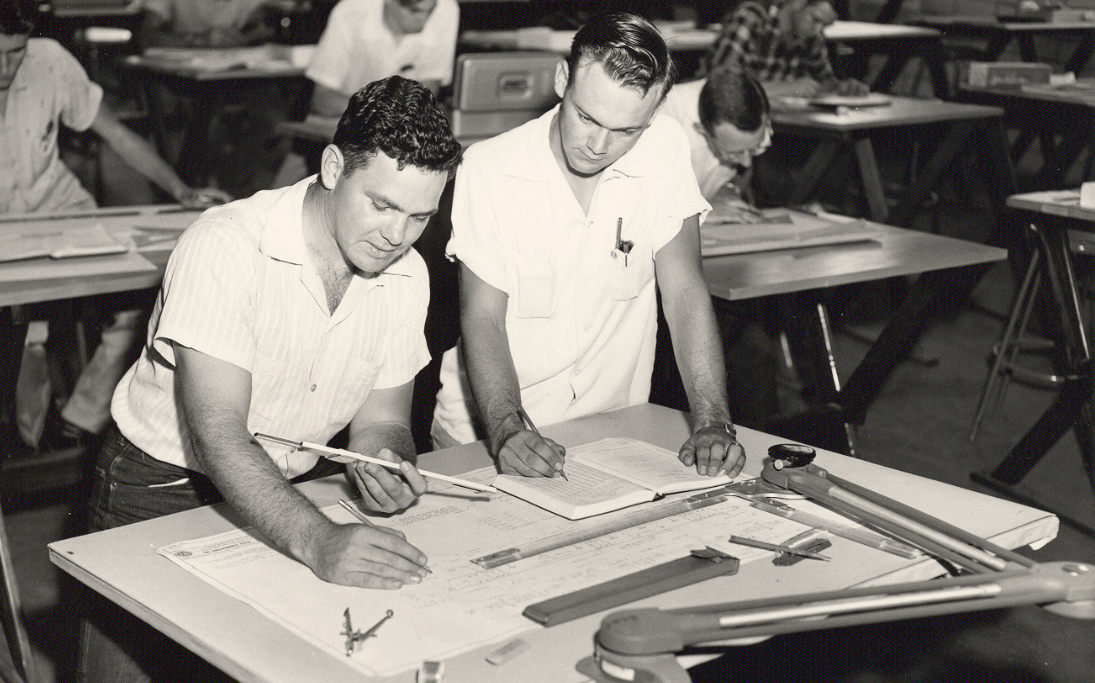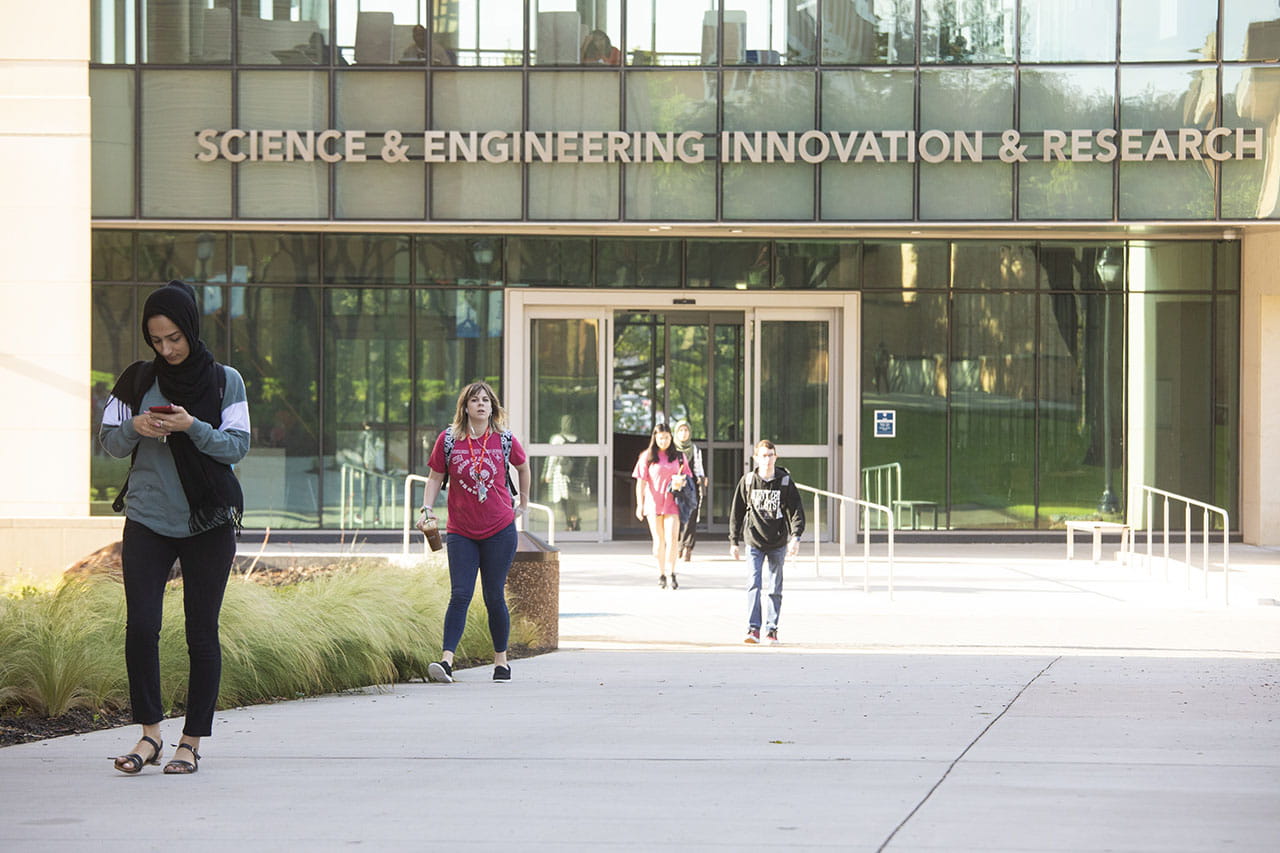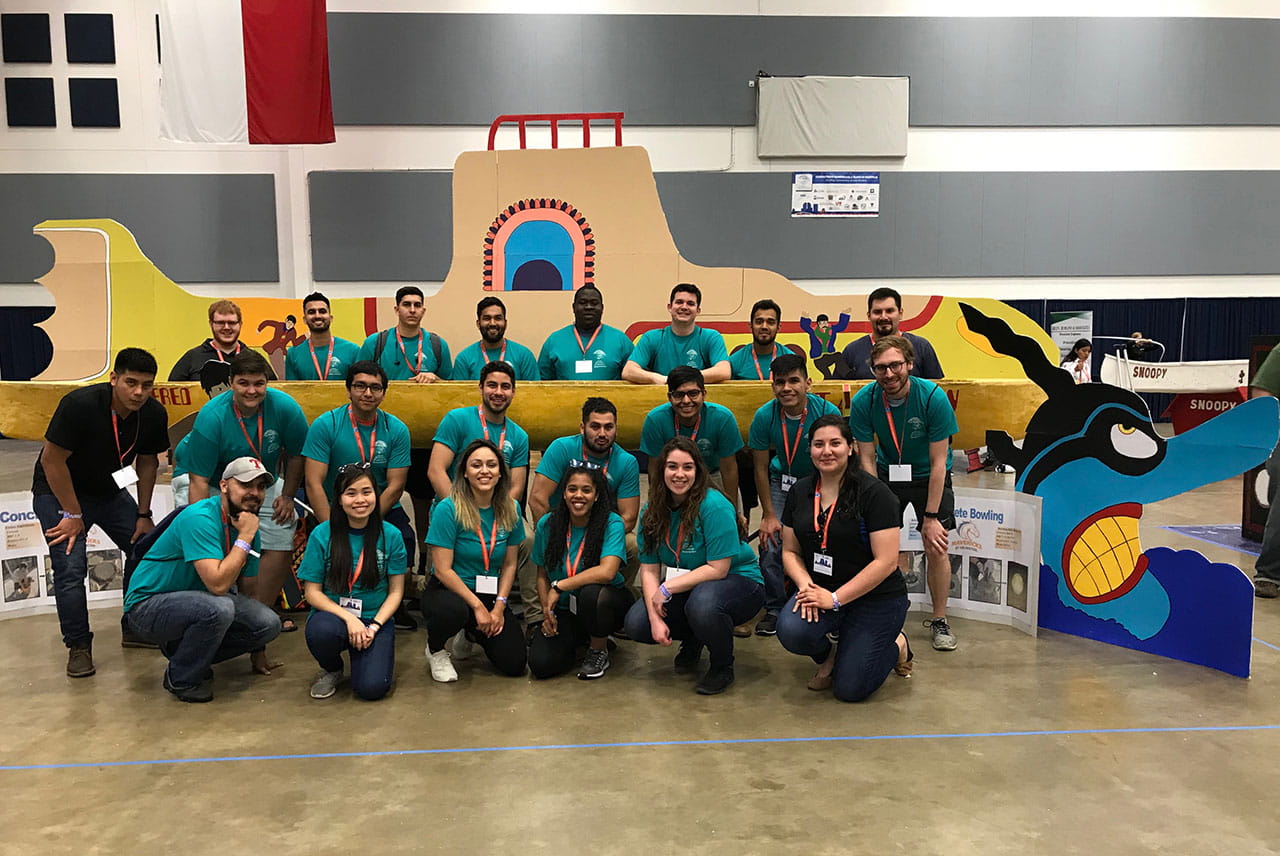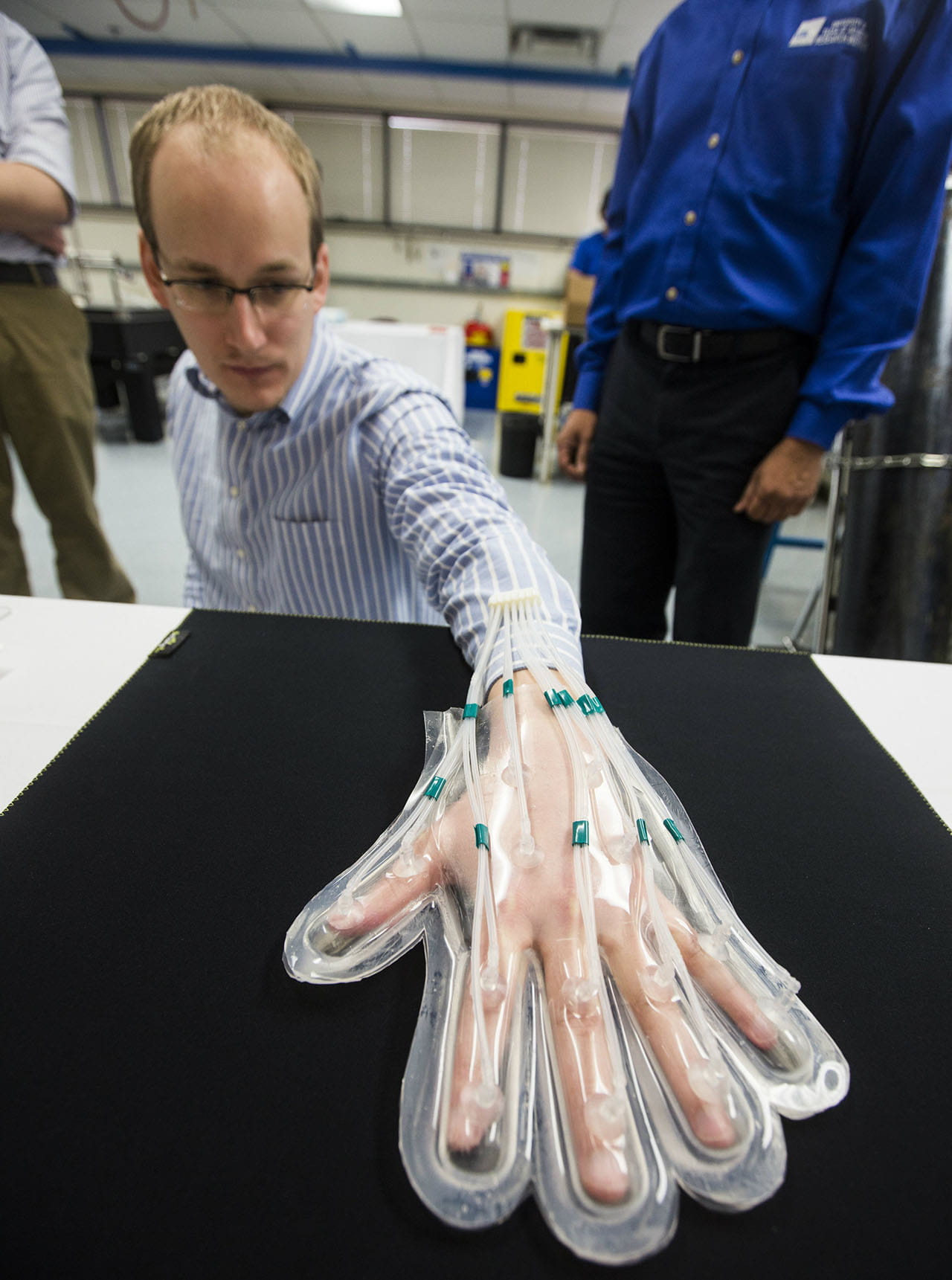Celebrating 60 years of engineers

Since its founding in 1959, The University of Texas at Arlington’s College of Engineering has been home to thousands of engineering students who have made their marks on the world.
More than 34,000 students have earned engineering degrees at UTA. With enrollment rapidly growing, new programs being added and record-breaking research funding rolling in, the college is poised to become an education and research powerhouse as it enters its next decade.
The college is celebrating its 60th anniversary on Friday, Feb. 21, with dinner and remarks from Jim Greer ’84, executive vice president and chief operating officer of Oncor; Peter Crouch, dean of the College of Engineering; and UTA Provost and Vice President for Academic Affairs Teik Lim.
Wendy Okolo, Ph.D. ’15 and B.S. ’10, will be recognized for the UTA Distinguished Recent Graduate Award she received from the University last fall, and Ayyappan Sankaran ’87 will receive the Hall of Achievement Award.
Early years

When Arlington State College (later UTA) was elevated to senior-college status in 1959, the transition included the creation of a new School of Engineering offering five baccalaureate degrees: aeronautical (later changed to aerospace), civil, electrical, industrial and mechanical engineering.
Wendell Nedderman, a professor of civil engineering at Texas A&M, was hired as the founding dean and held that position until 1969. In 1972 he became acting president, and in 1974, president, a position he held until his retirement in 1992.
Through it all, Nedderman worked tirelessly to build the School of Engineering. He successfully gained approval from the Texas Higher Education Coordinating Board to add graduate programs in 1966 and saw all five undergraduate programs receive accreditation by 1968.
In the early years of the graduate program, students were mostly practicing engineers who were looking to advance in their careers by taking master’s courses at night. Once the doctoral program was added in 1969, the college began building a solid reputation for research as well.
“The advent of the graduate program, and the deliberate fashion in which Dr. Nedderman and Jack Woolf [former Arlington State College president] approached it, were some of the biggest factors in the college’s success,” said Kent Lawrence, a professor of aerospace engineering who joined the faculty in 1961 and has worked at UTA for all but three years since then. “Many of our graduate students were inclined to research and were good at it. The money research grants brought in allowed us to do things we couldn’t before.
“A lot of our early faculty came from high-profile research institutions around the country, and Drs. Woolf and Nedderman pursued and hired faculty from top schools such as MIT and Cal Tech. It was extremely forward-thinking of them to hire that way, because it gave our college as broad a view of research as possible.”
Enrollment in the early years was around 1,500 students. By 1980, it had doubled to 3,000. Today, enrollment has soared past 7,600 and continues to grow.

Building boom
In the early years, the College of Engineering was located in Woolf Hall, which it shared with the departments of Foreign Languages and Business Administration. There were about 10 classrooms on the second floor, each with seven rows of seven desks and chairs bolted to the floor.
That began to change in 1985, when the UT System approved nearly $40 million for the construction of two new buildings—Nedderman Hall and the Aerospace Research Building—as well as a total renovation of Woolf Hall. One year later, a $10 million gift from the Fort Worth Chamber Foundation and Newell & Newell Developers created the Advanced Robotics Research Institute, now known as the UTA Research Institute.
There was another ribbon-cutting in 2001 with the opening of the Nanotechnology Research and Teaching Facility, which became the Shimadzu Institute Nanotechnology Research Center in 2013. In 2008, the Civil Engineering Laboratory Building opened on the west side of campus, while the Engineering Research Building debuted in 2011, providing much-needed office and laboratory space for the Computer Science and Engineering and Bioengineering departments. At the same time, significant renovations were completed and a third floor was added to the Engineering Laboratory Building. In 2018, the Science & Engineering Innovation & Research (SEIR) building opened on the south end of campus.

Who we are
The UTA of 2020 places a great emphasis on diversity. It is a Hispanic-Serving Institution, which is reflected in the College of Engineering’s student body. Last fall, 23% of engineering students were Hispanic, 21% were white, and 17% were Asian. International students accounted for 29% of enrollment, with these students hailing from 70 countries, including 17 in Africa, 14 in Asia, 14 in Europe and 12 in the Middle East.
One of those students was Letia Blanco ’11. Upon graduation, she helped create the Design Your World Conference for girls in partnership with UTA and the Society of Women Engineers (SWE), providing 6,000 girls from 5th grade to high school—most of them at-risk or from underserved communities—with hands-on programming and career conferences to help them pursue careers in engineering. The conference was recognized with a SWE Dallas Chapter Gold Chapter Award, and in October 2018 Blanco received the Distinguished New Engineer Award, an international honor.
“UTA has something for everyone. No matter your interest, there is a place to belong on campus,” Blanco said. “My involvement in SWE has led to a career-long commitment to mentoring and community involvement.”
Cultivating entrepreneurialism
The College of Engineering has a renewed focus on entrepreneurship, helped in large part by a generous donation from an alumnus that created the Maverick Entrepreneurship Program and Award Fund, which provides $500,000 in funding each year through 2021 for UTA students who are trying to start companies or bring inventions to market.
“When I came out of school, engineers either loved engineering and pursued a career in that, or they enjoyed the business side and went into management,” said Dick Moeller ’67, a member of the college’s Board of Advisors and a Hall of Achievement honoree. “When you take that step, you have to learn a lot of other skills, like marketing, sales, and how to read a balance sheet. Entrepreneurship has all of that.”
Moeller endowed a scholarship to assist engineering students who wish to pursue graduate degrees in business after graduation.
“Business and engineering are joined at the hip,” he said. “It’s not sufficient to have an engineering solution unless you have the business savvy to make it successful.”
In addition to entrepreneurship, students benefit from the required senior design capstone courses in each department. Many of these projects receive funding from outside sources, and some have led to greater opportunities.
For example, Blanco and her senior design teammates—Christopher Alberts, Kyle Godfrey, Andrew Patin, and Chris Grace—along with faculty advisers Panos Shiakolas and Pranesh Aswath, received a patent for a smart bandage, developed fully at UTA, that allows more efficient healing of wounds and the delivery of multiple drugs on their own time schedules to the wound. The invention won the American Society for Materials International Undergraduate Design Competition in 2011.
“We got to create something real and useful— something that mattered in the world,” Blanco said. “We did the whole thing in UTA labs, using UTA materials, with support from professors, lab managers and graduate students.”

Looking to the future
UTA is classified as Research-1 “Very High Research Activity” by the Carnegie Classification of Institutions of Higher Education, thanks in part to the strength of the College of Engineering. Annual research expenditures for the college exceed $40 million, and overall engineering-related research expenditures for the University are more than $55 million.
“With increased enrollment comes an increased ability to relate to the community and provide more opportunities to meet the needs of local, state and national industry,” said Lynn Peterson, senior associate dean for academic affairs. “It also allows us to hire high-quality faculty who will support research and innovation and help prepare our students for their future careers.”
Much has changed since 1959, but the college’s commitment to providing a top-quality engineering education and innovative, meaningful research has not.
“To have been here at the beginning and contributed to building the program was really something,” Lawrence said. “From those experiences, we’ve evolved into a responsive, smooth educational and research institution.”
— Written by Jeremy Agor, College of Engineering